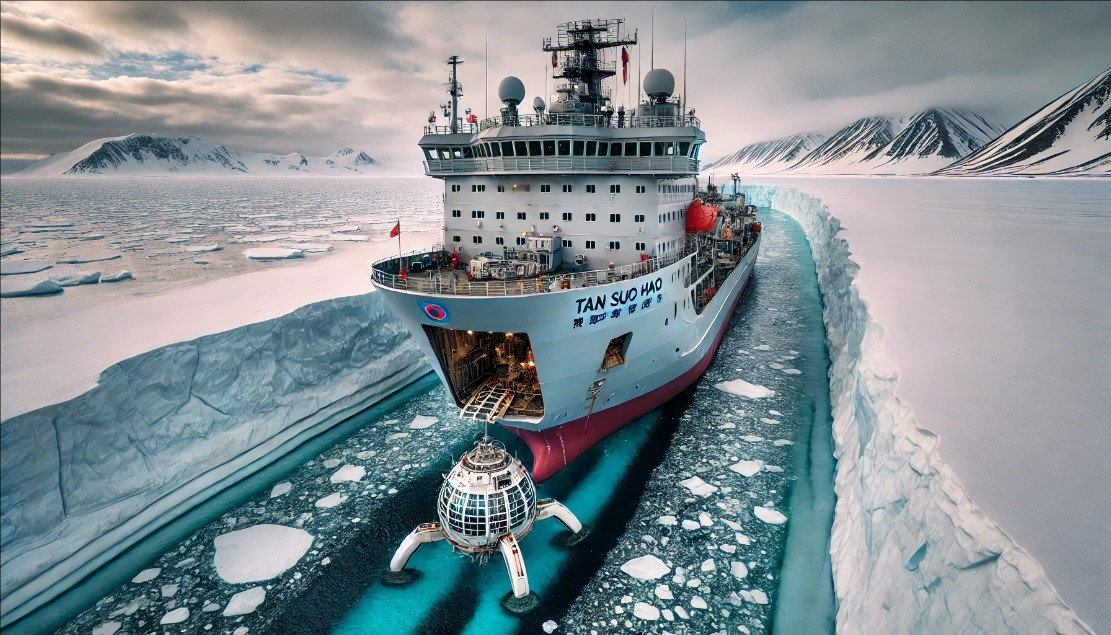China Plans to Send Crewed Submersible to Bottom of Arctic Seabed

China is setting its sights on a groundbreaking new frontier—exploring the depths of the Arctic Ocean with a crewed submersible. This bold mission, spearheaded by China’s State Shipbuilding Corporation's 704th Research Institute, is part of the nation's broader push to expand its scientific and strategic footprint in the Arctic region. As China gears up to be only the second country after Russia to send a manned vessel to the Arctic seabed, the mission promises to unlock new scientific knowledge and open up avenues for future resource exploration.
At the heart of this mission is the submersible that will be deployed from the newly built polar research vessel, **Tan Suo San Hao** (Explorer Three). This vessel has been carefully designed to tackle the unique challenges of Arctic exploration. The submersible will be launched through a special hole in the hull, allowing it to descend into the icy depths where few have ventured before. This feature ensures that the submersible can bypass the limitations posed by ice floes, which restrict the movement of surface ships. Once below the ice, the submersible will enter an environment that presents extreme technical challenges, but also immense opportunities for scientific discovery.
Advanced Chinese Technology for Arctic Exploration
What makes this mission particularly significant is the fact that China is relying on its own technology—something it previously had to source from other countries. The developers have already tested the submersible in various conditions, including underwater docking and operations in freezing temperatures, which are critical for the Arctic’s harsh environment. Although full specifications of the submersible remain undisclosed, China has highlighted that the system is versatile, with potential applications beyond Arctic research. The technology could be adapted for deep-sea oil and gas exploration, seabed pipeline construction, and even search and rescue operations, showcasing China’s growing technological prowess in deep-sea engineering.
To support the submersible, the Tan Suo San Hao has been outfitted with advanced equipment designed specifically for deep-sea missions. This includes a 10,000-meter winch system capable of lowering the submersible to the seabed and a deployment and recovery system that ensures safe operations in the unpredictable polar seas. All of this reflects China’s commitment to building a comprehensive, self-sufficient polar exploration fleet that can operate year-round, a feat previously achievable only by countries like Russia and the United States.
China’s Growing Polar Fleet and Strategic Ambitions
This mission is part of China’s larger strategy to strengthen its presence in the Arctic, a region it refers to as a "near-Arctic" power. Over the past few years, China has rapidly expanded its polar exploration capabilities. It has built multiple icebreakers, including the **Xue Long 2**, its first domestically produced vessel capable of navigating through thick ice. The newest icebreaker, the **Jidi**, embarked on its maiden voyage to the Arctic in August 2023, underscoring China’s growing ambition to maintain a strong, year-round presence in the region.
The submersible mission also highlights the geopolitical stakes in the Arctic. As melting ice opens new shipping routes and exposes untapped natural resources, countries like China, Russia, and the United States are increasingly vying for influence. The U.S. has expressed concern over China’s growing Arctic presence and has started boosting its own shipbuilding capabilities to keep up. Earlier this year, the U.S., along with Canada and Finland, launched a joint project to develop new polar vessels, including icebreakers, as a counter to China’s expanding fleet.
A New Chapter in Polar Exploration
China’s planned Arctic seabed mission is a testament to the country's growing technological and scientific capabilities. By building advanced submersibles and icebreakers, China is positioning itself as a key player in polar exploration—a region that holds untold scientific treasures and strategic resources. With the Tan Suo San Hao expected to begin sea trials next year, the world will be watching closely as China inches closer to its goal of reaching the bottom of the Arctic Ocean, paving the way for future discoveries and resource exploitation in one of the world’s most remote and fragile environments.
This mission is more than just a technological feat; it symbolizes China’s broader ambitions to exert influence in global polar affairs, securing a future where it plays a central role in the exploration and utilization of the Arctic’s vast, untapped potential.


